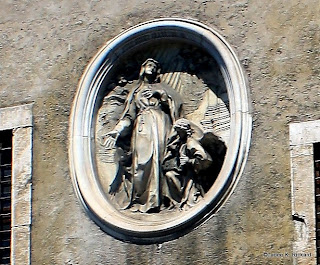From the Forum Boarium, we traveled north on Via Luigi Petroselli until we crossed Via del Foro Olitorio. The street then changed to Via del Teatro Marcello. This map should help you.
#1 on the map is San Nicola in Carcere (St. Nicholas in Prison). The overall history of the church is interesting. It is the finest example of "reuse" for sustainability that I have found. It was constructed from the ruins of the Forum Holitorium and its temples. Forum Holitorium was the market for vegetables, herbs and oil. Earlier this was the site of a temple of Venus. It stands on the ruins of three temples. And at one time a prison existed here.
This photo shows the front of San Nicola in Carcere, and the bell tower. The "spolia" from all of the ancient remains are still evident in the church. Spolia? You guessed it. This is a modern art-historical term used to describe the re-use of earlier building material or decorative sculptures on new monuments. Read more about the term spoila...click here. (Sorry about the tilting front porch. I was keeping the bell towers straight!)
This is the front view of Teatro di Marcello, shown next to the Temple of Apollo Sosianus (Italian Tempio di Apollo Sosiano. Click for information on the Temple.
#3 on the map, this shows the location of the Temples with respect to the theater. Several temples were destroyed so that there would be a great view of the theater. Not much re-use for the temples as pieces are scattered on the grounds. Perhaps bits and pieces were used on other projects. On the right side of the photo, the pinkish building, is Comune Di Roma Departmento Cultura. Their website, in English, tells about the cultural events happening throughout Rome.
Next to the tall columns of the Temple of Apollo Sosianus are the ruins of the Temple of Bellona. There is not much left of this temple.
Check out the buildings in the background. My guess is that these are apartments, still in use. I couldn't find anything to tell me what they are.
Beautiful work that has survived for centuries.
This google map will give you an idea of what I think is the monastery. The green line is the movement of the bus. The red arrow, pointing to the #1, shows where the photo was taken. The pink line shows what is included in the monastery. Is this possible???
Well, we traveled a few blocks and saw a lot. I learned a lot more by researching the buildings online using google, googlemaps, wikipedia, and the information posted on local Roman websites. If the tour guide made mention of these things as we passed, I would never remember it all. I take the photographs for me and you, so that I can remember and share with you. More to come.











2 comments:
Wow, even more that I didn't see! Was I ever really there???
I never saw these things during my first trip either. Different route, different sights. I took photos because the buildings look interesting. The tough part is finding the path that the tour took on google maps and identifying the buildings and monuments. My next camera will have the GPS option for sure. That would be a lot of help.
Post a Comment